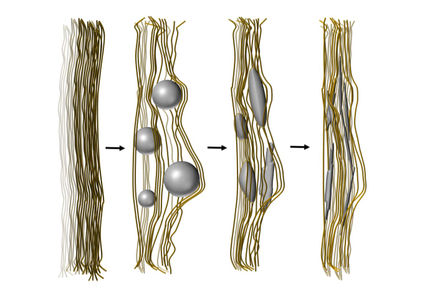3-D printed 'building blocks' of life
Scientists have developed a 3-D printing method capable of producing highly uniform 'blocks' of embryonic stem cells.
These cells - capable of generating all cell types in the body - could be used as the 'Lego bricks' to build tissue constructs, larger structures of tissues, and potentially even micro-organs.
"It was really exciting to see that we could grow embryoid body in such a controlled manner", explains Wei Sun, a lead author on the paper. "The grown embryoid body is uniform and homogenous, and serves as a much better starting point for further tissue growth."
The researchers, based at Tsinghua University, Beijing, China, and Drexel University, Philadelphia, USA, used extrusion-based 3-D printing to produce a grid-like 3-D structure to grow embryoid body that demonstrated cell viability and rapid self-renewal for 7 days while maintaining high pluripotentcy.
"Two other common methods of printing these cells are either two-dimensional (in a petri dish) or via the 'suspension' method (where a 'stalagmite' of cells is built up by material being dropped via gravity.)" continues Wei Sun. "However, these don't show the same cell uniformity and homogenous proliferation."
"I think that we've produced a 3-D microenvironment which is much more like that found in vivo for growing embryoid body, which explains the higher levels of cell proliferation."
The researchers hope that this technique can be developed to produce embryoid body at a high throughput, providing the basic building blocks for other researchers to perform experiments on tissue regeneration and/or for drug screening studies.
"Our next step is to find out more about how we can vary the size of the embryoid body by changing the printing and structural parameters, and how varying the embryoid body size leads to "manufacture" of different cell types" adds Rui Yao, another author on the paper.
"In the longer term, we'd like to produce controlled heterogeneous embryonic bodies" concludes Wei Sun. "This would promote different cell types developing next to each other - which would lead the way for growing micro-organs from scratch within the lab."
Original publication
Other news from the department science

Get the life science industry in your inbox
By submitting this form you agree that LUMITOS AG will send you the newsletter(s) selected above by email. Your data will not be passed on to third parties. Your data will be stored and processed in accordance with our data protection regulations. LUMITOS may contact you by email for the purpose of advertising or market and opinion surveys. You can revoke your consent at any time without giving reasons to LUMITOS AG, Ernst-Augustin-Str. 2, 12489 Berlin, Germany or by e-mail at revoke@lumitos.com with effect for the future. In addition, each email contains a link to unsubscribe from the corresponding newsletter.
Most read news
More news from our other portals
Last viewed contents
1925_serum_run_to_Nome
Soft_tissue_therapy
Zidovudine
X_chromosome
Non-invasive_(medical)
Category:EC_1.14
Hepatoenteritis



















































